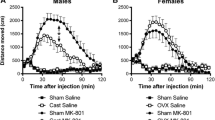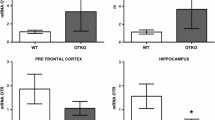Abstract
Rationale
Dopamine exerts its actions through at least five receptor (DAR) isoforms. In female rats, D5 DAR may be involved in expression of sexual behavior. We used a D5 knockout (D5KO) mouse to assess the role of D5 DAR in mouse sexual behavior. Both sexes of D5KO mice are fertile and exhibit only minor disruptions in exploratory locomotion, startle, and prepulse inhibition responses.
Objective
This study was conducted to characterize the sexual behavior of male and female D5KO mice relative to their WT littermates.
Methods
Female WT and D5KO littermates were ovariectomized and given a series of sexual behavior tests after treatment with estradiol benzoate (EB) and progesterone (P). Once sexual performance was optimal the dopamine agonist, apomorphine (APO), was substituted for P. Male mice were observed in pair- and trio- sexual behavior tests. To assess whether the D5 DAR is involved in rewarding aspects of sexual behavior, WT and D5KO male mice were tested for conditioned place preference.
Results
Both WT and D5KO females can display receptivity after treatment with EB and P, but APO was only able to facilitate receptivity in EB-primed WT, not in D5KO, mice. Male D5KO mice display normal masculine sexual behavior in mating tests. In conditioned preference tests, WT males formed a conditioned preference for context associated with either intromissions alone or ejaculation as the unconditioned stimulus. In contrast, D5KO males only showed a place preference when ejaculation was paired with the context.
Conclusions
In females, the D5 DAR is essential for the actions of dopamine on receptivity. In males, D5 DAR influences rewarding aspects of intromissions. Taken together, the work suggests that the D5 receptor mediates dopamine’s action on sexual behavior in both sexes, perhaps via a reward pathway.



Similar content being viewed by others

References
Agmo A, Berenfeld R (1990) Reinforcing properties of ejaculation in the male rat: role of opioids and dopamine. Behav Neurosci 104:177–182
Apostolakis EM, Garai J, Fox C, Smith CL, Watson SJ, Clark JH, O’Malley BW (1996) Dopaminergic regulation of progesterone receptors: brain D5 dopamine receptors mediate induction of lordosis by D1-like agonists in rats. J Neurosci 16:4823–4834
Apostolakis EM, Lanz R, O’Malley BW (2004) Pituitary adenylate cyclase-activating peptide: a pivotal modulator of steroid-induced reproductive behavior in female rodents. Mol Endocrinol 18(1):173–183
Auger AP, Meredith JM, Snyder GL, Blaustein JD (2001) Oestradiol increases phosphorylation of a dopamine- and cyclic AMP-regulated phosphoprotein (DARPP-32) in female rat brain. J Neuroendocrinol 13:761–768
Beach FA, Jordan L (1956) Effects of sexual reinforcement upon the performance of male rats in a straight runway. J Comp Physiol Psychol 49:105–110
Beach FA, Whalen RE (1959a) Effects of ejaculation on sexual behavior in the male rat. J Comp Physiol Psychol 52:249–254
Beach FA, Whalen RE (1959b) Effects of intromission without ejaculation upon sexual behavior in male rats. J Comp Physiol Psychol 52:476–491
Becker JB, Rudick CN, Jenkins WJ (2001) The role of dopamine in the nucleus accumbens and striatum during sexual behavior in the female rat. J Neurosci 21:3236–3241
Campbell JO, Wood RD, Spear LP (2000) Cocaine and morphine-induced place conditioning in adolescent and adult rats. Physiol Behav 68:487–493
Drago J, Gerfen CR, Lachowicz JE, Steiner H, Hollon TR, Love PE, Ooi GT, Grinberg A, Lee EJ, Huang SP, Bartlett PF, Jose PA, Sibley DR, Westphal H (1994) Altered striatal function in a mutant mouse lacking D1A dopamine receptors. Proc Natl Acad Sci U S A 91:12564–12568
Eiler WJ II, Seyoum R, Foster KL, Mailey C, June HL (2003) D1 dopamine receptor regulates alcohol-motivated behaviors in the bed nucleus of the stria terminalis in alcohol-preferring (P) rats. Synapse 48:45–56
Elliot EE, Sibley DR, Katz JL (2003) Locomotor and discriminative-stimulus effects of cocaine in dopamine D(5) receptor knockout mice. Psychopharmacology 169(2):161–168
Everitt BJ, Parkinson JA, Olmstead MC, Arroyo M, Robledo P, Robbins TW (1999) Associative processes in addiction and reward. The role of amygdala-ventral striatal subsystems. Ann NY Acad Sci 877:412–438
Fienberg AA, Greengard P (2000) The DARPP-32 knockout mouse. Brain Res Brain Res Rev 31:313–319
Filip M, Thomas ML, Cunningham KA (2000) Dopamine D5 receptors in nucleus accumbens contribute to the detection of cocaine in rats. J Neurosci 20(19):RC98
Frye CA, Vongher JM (1999) GABAA, D1, and D5 but not progestin receptor, antagonist and anti-sense oligonucleotide infusions to the ventral tegmental area of cycling rats and hamsters attenuate lordosis. Behav Brain Res 103:23–34
Hollon TR, Gleason TC, Grinberg A, Ariano MA, Huang SP, Drago J, Dreiling J, Crawley JR, Westphal H, Sibley DR (1998) Generation of D5 dopamine receptor-deficient mice by gene targeting. Abstr Soc Neurosci 24:594
Hollon TR, Bek MJ, Lachowicz JE, Ariano MA, Mezey E, Ramachandran R, Wersinger SR, Soares-da-Silva P, Liu ZF, Grinberg A, Drago J, Young WS III, Westphal H, Jose PA, Sibley DR (2002) Mice lacking D5 dopamine receptors have increased sympathetic tone and are hypertensive. J Neurosci 22:10801–10810
Holmes A, Hollon TR, Gleason TC, Liu Z, Dreiling J, Sibley DR, Crawley JN (2001) Behavioral characterization of dopamine D5 receptor null mutant mice. Behav Neurosci 115:1129–1144
Hughes AM, Everitt BJ, Herbert J (1990) Comparative effects of preoptic area infusions of opioid peptides, lesions and castration on sexual behaviour in male rats: studies of instrumental behaviour, conditioned place preference and partner preference. Psychopharmacology (Berl) 102:243–256
Hyun JS, Bivalacqua TJ, Baig MR, Yang DY, Leungwattanakij S, Abdel-Mageed A, Kim KD, Hellstrom WJG (2002) Localization of peripheral dopamine D1 and D2 receptors in rat corpus cavernosum. Br J Urol Int 90:105–112
Ikemoto S, Panksepp J (1999) The role of nucleus accumbens dopamine in motivated behavior: a unifying interpretation with special reference to reward-seeking. Brain Res Brain Res Rev 31:6–41
Jackson DM, Westlind-Danielsson A (1994) Dopamine receptors: molecular biology, biochemistry and behavioural aspects. Pharmacol Ther 64:291–370
Jenkins WJ, Becker JB (2003a) Female rats develop conditioned place preferences for sex at their preferred interval. Horm Behav 43:503–507
Jenkins WJ, Becker JB (2003b) Dynamic increases in dopamine during paced copulation in the female rat. Eur J Neurosci 18:1997–2001
Khan ZU, Gutierrez A, Martin R, Penafiel A, Rivera A, De La Calle A (2000) Dopamine D5 receptors of rat and human brain. Neuroscience 100:689–699
Kudwa AE, Rissman EF (2003) Double oestrogen receptor α and β knockout mice reveal differences in neural oestrogen-mediated progestin receptor induction and female sexual behaviour. J Neuroendocrinol 15:978–983
Lopez HH, Ettenberg A (2002) Sexually conditioned incentives: attenuation of motivational impact during dopamine receptor antagonism. Pharmacol Biochem Behav 72:65–72
Maldonado R, Saiardi A, Valverde O, Samad TA, Roques BP, Borrelli E (1997) Absence of opiate rewarding effects in mice lacking dopamine D2 receptors. Nature 388:586–589
Mani S (2001) Ligand-independent activation of progestin receptors in sexual receptivity. Horm Behav 40:183–190
Mani SK, Allen JM, Clark JH, Blaustein JD, O’Malley BW (1994) Convergent pathways for steroid hormone- and neurotransmitter-induced rat sexual behavior. Science 265:1246–1249
Mani SK, Allen JM, Lydon JP, Mulac-Jericevic B, Blaustein JD, DeMayo FJ, Conneely O, O’Malley BW (1996) Dopamine requires the unoccupied progesterone receptor to induce sexual behavior in mice. Mol Endocrinol 10:1728–1737
Mani SK, Fienberg AA, O’Callaghan JP, Snyder GL, Allen PB, Dash PK, Moore AN, Mitchell AJ, Bibb J, Greengard P, O’Malley BW (2000) Requirement for DARPP-32 in progesterone-facilitated sexual receptivity in female rats and mice. Science 287:1053–1056
Martinez I, Paredes RG (2001) Only self-paced mating is rewarding in rats of both sexes. Horm Behav 40:510–517
McCarthy MM, Kleopoulos SP, Mobbs CV, Pfaff DW (1994) Infusion of antisense oligodeoxynucleotides to the oxytocin receptor in the ventromedial hypothalamus reduces estrogen-induced sexual receptivity and oxytocin receptor binding in the female rat. Neuroendocrinology 59:432–440
Mehrara BJ, Baum MJ (1990) Naloxone disrupts the expression but not the acquisition by male rats of a conditioned place preference response for an oestrous female. Psychopharmacology (Berl) 101:118–125
Meredith JM, Moffatt CA, Auger AP, Snyder GL, Greengard P, Blaustein JD (1998) Mating-related stimulation induces phosphorylation of dopamine- and cyclic AMP-regulated phosphoprotein-32 in progestin receptor-containing areas in the female rat brain. J Neurosci 18:10189–10195
Mermelstein PG, Becker JB (1995) Increased extracellular dopamine in the nucleus accumbens and striatum of the female rat during paced copulatory behavior. Behav Neurosci 109:354–365
Miller RL, Baum MJ (1987) Naloxone inhibits mating and conditioned place preference for an estrous female in male rats soon after castration. Pharmacol Biochem Behav 26:781–789
Miner LL, Drago J, Chamberlain PM, Donovan D, Uhl GR (1995) Retained cocaine conditioned place preference in D1 receptor deficient mice. NeuroReport 6:2314–2316
Missale C, Nash SR, Robinson SW, Jaber M, Caron MG (1998) Dopamine receptors: from structure to function. Physiol Rev 78:189–225
Moses J, Loucks JA, Watson HL, Matuszewich L, Hull EM (1995) Dopaminergic drugs in the medial preoptic area and nucleus accumbens: effects on motor activity, sexual motivation, and sexual performance. Pharmacol Biochem Behav 51:681–686
Paredes RG, Alonso A (1997) Sexual behavior regulated (paced) by the female induces conditioned place preference. Behav Neurosci 111:123–128
Paredes RG, Martinez I (2001) Naloxone blocks place preference conditioning after paced mating in female rats. Behav Neurosci 115:1363–1367
Peciña S, Cagniard B, Berridge KC, Aldridge JW, Zhuang X (2003) Hyperdopaminergic mutant mice have higher “wanting” but not “liking” for sweet rewards. J Neurosci 23:9395–9402
Pfaus JG, Damsma G, Wenkstern D, Fibiger HC (1995) Sexual activity increases dopamine transmission in the nucleus accumbens and striatum of female rats. Brain Res 693:21–30
Pollio G, Xue P, Zanisi M, Nicolin A, Maggi A (1993) Antisense oligonucleotide blocks progesterone-induced lordosis behavior in ovariectomized rats. Brain Res Mol Brain Res 19:135–139
Russo SJ, Festa ED, Fabian SJ, Gazi FM, Kraish M, Jenab S, Quinones-Jenab V (2003) Gonadal hormones differentially modulate cocaine-induced conditioned place preference in male and female rats. Neuroscience 120:523–533
Sunahara RK, Guan HC, O’Dowd BF, Seeman P, Laurier LG, Ng G, George SR, Torchia J, Van Tol HH, Niznik HB (1991) Cloning of the gene for a human dopamine D5 receptor with higher affinity for dopamine than D1. Nature 350:614–619
Tiberi M, Jarvie KR, Silvia C, Falardeau P, Gingrich JA, Godinot N, Bertrand L, Yang-Feng TL, Fremeau RT Jr, Caron MG (1991) Cloning, molecular characterization, and chromosomal assignment of a gene encoding a second D1 dopamine receptor subtype: differential expression pattern in rat brain compared with the D1A receptor. Proc Natl Acad Sci U S A 88:7491–7495
Tzschentke TM (1998) Measuring reward with the conditioned place preference paradigm: a comprehensive review of drug effects, recent progress and new issues. Prog Neurobiol 56:613–672
Viggiano D, Ruocco LA, Sadile AG (2004) Dopamine phenotype and behavior in animal models: in relation to attention deficit disorder. Neurosci Biobehav Rev 27:623–637
Wersinger SR, Rissman EF (2000) Dopamine activates masculine sexual behavior independent of the estrogen receptor alpha. J Neurosci 20:4248–4254
Whalen RE (1961) Effects of mounting without intromission and intromission without ejaculation on sexual behavior and maze learning. J Comp Physiol Psychol 54:409–415
Witt DM, Insel TR (1991) A selective oxytocin antagonist attenuates progesterone facilitation of female sexual behavior. Endocrinology 128:3269–3276
Xu M, Moratalla R, Gold LH, Hiroi N, Koob GF, Graybiel AM, Tonegawa S (1994) Dopamine D1 receptor mutant mice are deficient in striatal expression of dynorphin and in dopamine-mediated behavioral responses. Cell 79:729–742
Acknowledgements
The authors would like to thank Aileen Wills and Savera Shetty for technical assistance. We thank Dr. Melissa Burns-Cusato for insightful comments on the final draft of this paper. This work was supported by NIH grants R01 MH57759 and K02 MH01349 (EFR). AEK was supported by NIH training grant HD072323.
Author information
Authors and Affiliations
Corresponding author
Additional information
A.E. Kudwa and E. Dominguez-Salazar are co-authors.
Rights and permissions
About this article
Cite this article
Kudwa, A.E., Dominguez-Salazar, E., Cabrera, D.M. et al. Dopamine D5 receptor modulates male and female sexual behavior in mice. Psychopharmacology 180, 206–214 (2005). https://doi.org/10.1007/s00213-005-2150-5
Received:
Accepted:
Published:
Issue Date:
DOI: https://doi.org/10.1007/s00213-005-2150-5



